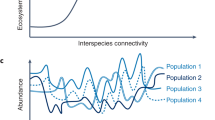Abstract
The evolutionary implications of environmental change due to organismic action remain a controversial issue, after a decades—long debate on the subject. Much of this debate has been conducted in qualitative fashion, despite the availability of mathematical models for organism–environment interactions, and for gene frequencies when allele fitness can be related to exploitation of a particular environmental resource. In this article we focus on representative models dealing with niche construction, ecosystem engineering, the Gaia Hypothesis and community interactions of Lotka–Volterra type, and show that their quantitative character helps bring into sharper focus the similarities and differences among their respective theoretical contexts.

Similar content being viewed by others
References
Ackland GJ, Gallagher ID (2004) Stabilization of large generalized Lotka-Volterra foodwebs by evolutionary feedback. Phys Rev Letts 93(15):158701
Boni MF, Feldman MW (2005) Evolution of antibiotic resistance by humans and bacterial niche construction. Evolution 59(3):477–491
Dawkins R (1999) The extended phenotype, 2nd edn. Oxford University Press, Oxford
Dawkins R (2006) The selfish gene, 3rd edn. Oxford University Press, Oxford
Gurney WSC, Lawton JH (1996) The population dynamics of ecosystem engineers. Oikos 76(2):273–83
Hooke R (1994) On the efficacy of humans as geomorphic agents. GSA Today 4(9):224–225
Hooke R (2000) On the history of humans as geomorphic agents. Geology 28(9):843–846
Hubbell SP (2001) The unified neutral theory of biodiversity and biogeography. Princeton University Press, Princeton
Jablonka E, Lamb MJ (2006) Evolution in four dimensions. The MIT Press, Cambridge, MA, USA
Jones CG, Lawton JH, Shachak M (1994) Organisms as ecosystem engineers. Oikos 69:373–386
Jones CG, Lawton JH, Shachak M (1997) Positive and negative effects of organisms as physical ecosystem engineers. Ecology 78(7):1946–1957
Laland LN (2004) Extending the extended phenotype. Biol Philos 19:313–325
Laland KN, Sterelny K (2006) Perspective: seven reasons (not) to neglect niche construction. Evolution 60(9):1751–1762
Laland LN, Odling-Smee FJ, Feldman MW (1999) Evolutionary consequences of niche construction and their implications for ecology. Proc Natl Acad Sci USA 96:10242–10247
Leigh ER (1968) The ecological role of Volterra’s equations. In: Gersten-haber M (ed) Some mathematical problems in biology, American Mathematical Society, Providence, RI, pp 1–61
Lenton TM (1998) Gaia and natural selection. Nature 394:439–447
Lewontin RC (1982) Organism and environment. In: Plotkin HC (ed) Learning, development and culture, Wiley, New York, pp 151–170
Lewontin RC (1983) The organism as the subject and object of evolution. Scientia 118:65–82
Lotka AJ (1956) Elements of mathematical biology. Dover Publications, New York, USA
Lovelock JE, Margulis L (1974) Atmospheric homeostasis by and for the biosphere: the gaia hypothesis. Tellus 26:2–10
May RM (2001) Stability and complexity in model ecosystems. Princeton University Press, Princeton
Metz B, Davidson O, Bosch P et al (eds) (2007) Climate change 2007: mitigation. contribution of working group III to the fourth assessment report of the intergovernmental panel on climate change. Cambridge University Press, Cambridge
Odling-Smee FJ, Laland KN, Feldman MW (2003) Niche construction: the neglected process in evolution. Princeton University Press, Princeton
Orr JC, Fabry VJ, Aumont O et al (2005) Anthropogenic ocean acidification over the twenty-first century and its impact on calcifying organisms. Nature 437:681–686
Pippard AB (1974) The elements of classical thermodynamics, Chapter 7. Cambridge University Press, London
Sugimoto T (2002) Darwinian evolution does not rule out the Gaia Hypothesis. J Theoret Biol 218:447–455. doi:10.1006/yjtbi.3091
Torres J-L (2001) Biological power laws and Darwin’s principle. J Theoret Biol 209:223–232
Torres J-L, Castillo-Guajardo D, Equihua M, Pérez-Maqueo O, Sosa V, Torres L (2007) On a new method to study drastic change in ecosystems. Bull Math Biol 69:1815–1826
Vitousek PM, Mooney HA, Lubchenco J et al (1997) Human domination of earth’s ecosystems. Science 277:494–499
Volterra V (1926) Fluctuations in the abundance of a species considered mathematically. Nature 118:558–560
Watson AJ, Lovelock JE (1983) Biological homeostasis of the global environment: the parable of Daisyworld. Tellus 35B:284–289
Author information
Authors and Affiliations
Corresponding author
Rights and permissions
About this article
Cite this article
Torres, JL., Pérez-Maqueo, O., Equihua, M. et al. Quantitative assessment of organism–environment couplings. Biol Philos 24, 107–117 (2009). https://doi.org/10.1007/s10539-008-9119-9
Received:
Accepted:
Published:
Issue Date:
DOI: https://doi.org/10.1007/s10539-008-9119-9




